List of heads of state of Lithuania
| President of the Republic of Lithuania | |
|---|---|
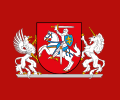 | |
 | |
| Residence | Presidential Palace Vilnius |
| Appointer | Popular vote |
| Term length | Five years renewable once, consecutively |
| Inaugural holder | Antanas Smetona 4 April 1919 |
| Formation | Constitution of Lithuania |
| Salary | 312,000 Lt[1] |
| Website | Lietuvos Respublikos Prezidentė |
 |
|---|
The following is a list of rulers over Lithuania — grand dukes, kings, and presidents – the heads of authority over historical Lithuanian territory. The timeline includes Lithuania as a sovereign entity or legitimately part of a greater sovereign entity as well as Lithuania under control or occupation of an outside authority (i.e., Lithuanian Soviet Socialist Republic). The incumbents and office-holders are listed by names most commonly used in English language. Where appropriate, the alternations in Lithuanian, Ruthenian (later Belarusian) and Polish are included.
The state of Lithuania formed in 1230s, when threatened by the Livonian Order in the north and the Teutonic Knights in the west, Baltic tribes united under Mindaugas leadership. He became the only crowned king of Lithuania. His state became known as Grand Duchy of Lithuania. After Grand Duke Jogaila became also king of Poland in 1386, the two states became closer connected and since 1440 both were ruled by a common ruler. In 1569 Union of Lublin was signed and a new entity—the Polish–Lithuanian Commonwealth—emerged. The commonwealth was partitioned in 1795 and Lithuania became part of the Russian Empire till 16 February 1918. The Council of Lithuania was able to establish the sovereignty only in 1919, after Germany lost World War I. The first republic of Lithuania existed till 1940 when it was occupied by the Soviet Union. During the Soviet-German War, Lithuania was occupied by Nazi Germany. In 1944, as Germany was losing the war, Russia re-occupied Lithuania and established the Lithuanian Soviet Socialist Republic. On 11 March 1990, Lithuania became the first Soviet republic to declare independence. The restored Republic of Lithuania is a democratic republic, a member of both the European Union and NATO.
Grand Duchy of Lithuania (1236–1569)
Title: Grand Duke (Lithuanian: didysis kunigaikštis; Belarusian: vialiki kniaź; Polish: wielki książę) except for Mindaugas, who became king of Lithuania (Lithuanian: Lietuvos karalius).
House of Mindaugas (1236–1285)
Dates are approximate because of scant written sources.
| Term | Grand Duke | Image | Remarks |
|---|---|---|---|
| c. 1236–1263 | Mindaugas |  |
Initially Grand Duke, since 1253 King of Lithuania. After he was killed by his nephew Treniota, a war between nobles for power erupted. |
| 1263–1265 | Treniota | 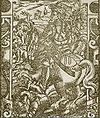 |
|
| 1265–1268 | Vaišvilkas | 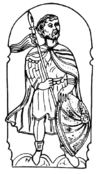 |
Son of Mindaugas, voluntarily gave up the throne for the benefit of his brother-in-law Shvarn |
| 1268–1269 | Švarnas | ||
| 1270–1282 | Traidenis | 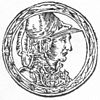 |
|
| 1282–1285 | Daumantas |
House of Gediminas (1285–1440)
Some dates are approximate.
| Term | Grand Duke | Image | Remarks |
|---|---|---|---|
| 1285–1291 | Butigeidis | Founder of the Gediminid dynasty | |
| 1291–1295 | Butvydas | Brother of Butigeidis, father of Vytenis and Gediminas | |
| 1295–1316 | Vytenis | 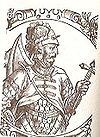 |
Son of Butvydas |
| 1316–1341 | Gediminas |  |
Son of Butvydas. After his death the domain was divided between his 7 sons. |
| 1341–1345 | Jaunutis | Son of Gediminas. Overlord and Grand Duke, deposed by his brothers Algirdas and Kęstutis. | |
| 1345–1377 | Algirdas | 
|
Son of Gediminas. His co-ruler was Kęstutis, who was active in the west. Algirdas was mostly active in the east. |
| 1377–1381 | Jogaila | 
|
Son of Algirdas. Crowned the King of Poland in 1386 and established the personal union of Lithuania and Poland. Founder of the House of Jogailaičiai. |
| 1381–1382 | Kęstutis | 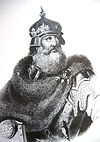
|
Son of Gediminas, co-ruler with Algirdas. Kęstutis ruled the western Lithuania (with capital in Trakai). Deposed Jogaila in 1381 and took control of the whole of Lithuania, only to be captured and killed by him the next year. |
| 1382–1392 | Jogaila | 
|
Also King of Poland 1386–1434. His governor in Lithuania was Skirgaila (1387–1392). |
| 1392–1430 | Vytautas the Great | 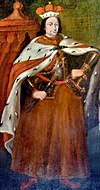
|
Son of Kęstutis. Joined his father in the fight against Jogaila, then changed sides and became Grand Duke of Lithuania in 1392. Was to be crowned King of Lithuania in 1429, but the crown was stopped by the Poles. Died before the second crown arrived. |
| 1430–1432 | Švitrigaila | 
|
Son of Algirdas, brother of Jogaila. Deposed by followers of Žygimantas, son of Kęstutis. |
| 1432–1440 | Sigismund Kęstutaitis | 
|
Son of Kęstutis, brother of Vytautas. Killed by Švitrigaila supporters. |
House of Jagiellon (1440–1569)
The act of personal union with Poland was signed as early as 1385, however, continuous line of common rulers of the two countries started only with Casimir IV (even then Polish and Lithuanians twice selected different rulers following earlier common monarch's death, but the Lithuanian one always eventually assumed the Polish throne). The monarchs retained separate titles for both parts of the state, and their numbering was kept separately. The Jagiellon dynasty was a direct continuation of the Gediminids.
| Term | Incumbent | Image | Remarks |
|---|---|---|---|
| 1440–1492 | Casimir IV Jagiellon | 
|
Son of Jogaila. Elected and crowned King of Poland in 1447 after the death of king Wladyslaw Warnenczyk |
| 1492–1506 | Alexander I | 
|
Son of Casimir IV. Elected and crowned King of Poland in 1501 after the death of king Jan I Olbracht |
| 1506–1548 | Sigismund II | 
|
Son of Casimir IV. |
| 1548–1569 | Sigismund III | 
|
Son of Sigismund I the Old. Factual ruler since 1529. |
Polish–Lithuanian Commonwealth (1569–1795)
The Polish–Lithuanian Commonwealth was established by Union of Lublin in 1569. The elected King of Poland was to be elected by Lithuanian noble families as a Grand Duke of Lithuania (until then Lithuanian dukedom was hereditary). The first ruler of the common country was Sigismund II Augustus. Following the partitions in 1772, 1793, and 1795, the commonwealth ceased to exist and Lithuania became part of the Russian Empire for 123 years. There are some gaps in the timeline as it took a while to elect a new king. The first Grand Duke elected after the Gediminyds line went extinct and after the Valois fled back to France was Stephen Báthory, who had made an effort to be recognized as Grand Duke of Lithuania by establishing Vilnius University.
Title: King of Poland and Grand Duke of Lithuania (Lithuanian: Lenkijos karalius ir Lietuvos didysis kunigaikštis; Belarusian: karol Polščy, vialiki kniaź litoŭski; Polish: Król Polski, wielki książę litewski).
| Term | Incumbent | Image | House | Remarks | |
|---|---|---|---|---|---|
| 1569–1572 | Sigismund II Augustus | 
|
Jagiellon | Son of Sigismund I the Old. | |
| 1573–1575 | Henry Valois | 
|
Valois | He abandoned the throne and fled to France where he was crowned as Henry III. | |
| 1576–1586 | Stephen Bathory |  |
Báthory | Báthory | |
| 1588–1632 | Sigismund III Vasa | 
|
Vasa | Proponent of a personal union between The Republic and Sweden, King of Sweden between 1592 and 1599. | |
| 1632–1648 | Ladislaus IV Vasa | 
|
|||
| 1648–1668 | John II Casimir Vasa | 
|
Abdicated and became a monk, last of the Vasa dynasty in Poland-Lithuania. | ||
| 1669–1673 | Michael Korybut Wiśniowiecki | 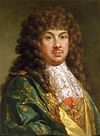
|
Lithuanian nobility | ||
| 1674–1696 | John III Sobieski | 
|
Polish szlachta | ||
| 1697–1706 | Augustus II the Strong | 
|
Wettin | also Elector of Saxony as Frederick Augustus I. | |
| 1706–1709 | Stanislaus Leszczyński | 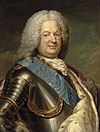
|
Polish szlachta | Great Northern War. | |
| 1709–1733 | Augustus II the Strong | 
|
Wettin | also Elector of Saxony as Frederick Augustus I. | |
| 1733–1736 | Stanislaus Leszczyński | 
|
Polish szlachta | War of Polish Succession. | |
| 1733–1763 | August III Wettin | 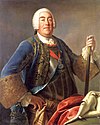
|
Wettin | ||
| 1764–1795 | Stanislaus August II | 
|
Polish szlachta | During his reign the merger of the Grand Duchy with the Kingdom of Poland was passed in 1791; abdicated following the Partitions of Poland; died in exile in Russia. |
Kingdom of Lithuania (1918)
The Council of Lithuania declared independence on 16 February 1918 when Lithuania was occupied by the Reichswehr. The name of the state was the Kingdom of Lithuania. On 9 July 1918, the council declared that the Duke of Urach is to become King Mindaugas II of Lithuania. However, on 2 November, the council revoked this decision and declared that Lithuania is to be a democratic republic.
| Term | Incumbent | Image | House | Remarks |
|---|---|---|---|---|
| 11 July – 2 November 1918 | Mindaugas II (Wilhelm Karl) |

|
Württemberg | Government change to a democratic republic. |
Republic of Lithuania (1918–1940)
The institution of President (Lithuanian: Prezidentas) was created on 4 April 1919.
| No | Term | President | Image | Remarks |
|---|---|---|---|---|
| 1 | 4 April 1919 – 19 June 1920 | Antanas Smetona | 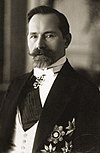
|
Elected by the Council of Lithuania. |
| 2 | 19 June 1920 – 7 June 1926 | Aleksandras Stulginskis | 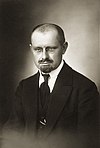
|
Acting President (as Constituent Assembly). Re-elected by the Seimas on 21 December 1922 and in June 1923. |
| 3 | 7 June – 18 December 1926 | Kazys Grinius | 
|
Elected by parliament, but overthrown by a military coup d'état. |
| 18–19 December 1926 | Jonas Staugaitis | 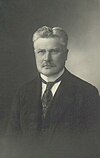
|
Formally, for one day, as the head of Seimas (renounced the office after the coup d'état). | |
| 19 December 1926 | Aleksandras Stulginskis | 
|
Formally, as the new head of Seimas, only for several hours. | |
| 19 December 1926 – 15 June 1940 | Antanas Smetona | 
|
Second term, elected president after a military coup d'état; after the Soviet ultimatum of 1940 he fled to Germany and then to the USA. | |
| 15–17 June 1940 | Antanas Merkys | 
|
The Prime Minister, de facto acting president after Smetona's defection. Not recognised by Lithuanian diplomats abroad; he assumed the role of president illegally, as Smetona neither resigned nor died. | |
| 17 June – August, 1940 | Justas Paleckis | File:Justas Paleckis.jpg | Chosen unconstitutionally by leaders of the Lithuanian communists under pressure from the Soviet Union, not recognized internationally or by the Lithuanian diplomatic service. | |
| 4 | 16 February 1949 – 26 November 1954 | Jonas Žemaitis | 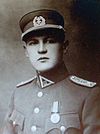
|
Officially named as the fourth President of Lithuania in March 2009. |
Lithuanian Soviet Socialist Republic (1940–1941 and 1944–1990)
The Soviet Union occupied Lithuania and established Lithuanian SSR in July 1940. As Nazi Germany attacked the Soviet Union, Lithuania was occupied by the Germans. For a few days before the German occupation, Lithuania was ruled by pro-German rebel government of Juozas Ambrazevičius. Under the Germans, the General District of Lithuania was governed by the administration of general Petras Kubiliūnas. As Nazi Germany retreated, the Soviet Union reoccupied the country and reestablished the Lithuanian SSR in 1944.
Title: First Secretary of the Central Committee of the Communist Party of Lithuania (Lithuanian: Lietuvos komunistų partijos Centro komiteto pirmasis sekretorius; Russian: Первый секретарь Центрального Комитета Коммунистической партии Литвы).
| No | Term | First Secretary | Remarks |
|---|---|---|---|
| 1 | 21 July 1940 – 24 June 1941 13 July 1944 – 22 January 1974 |
Antanas Sniečkus | |
| 2 | 18 February 1974 – 14 November 1987 | Petras Griškevičius | |
| 3 | 1 December 1987 – 19 October 1988 | Ringaudas Bronislovas Songaila | First leader of the party to be deposed of his power (Sniečkus and Griškevičius held office until their death) |
| 4 | 19 October 1988 – 11 March 1990 | Algirdas Mykolas Brazauskas | Lost power as independence was declared |
The Presidium of the Supreme Soviet acted as a collective head of state from 25 August 1940 to 11 March 1990.
| Term | Chairman of the Presidium of the Supreme Soviet | Remarks |
|---|---|---|
| 25 August 1940 – 14 April 1967 | Justas Paleckis | In Russian SFSR exile 1941–1944 |
| 14 April 1967 – 24 December 1975 | Motiejus Šumauskas | |
| 24 December 1975 – 18 November 1985 | Antanas Barkauskas | |
| 18 November 1985 – 7 December 1987 | Ringaudas Songaila | |
| 7 December 1987 – 15 January 1990 | Vitautas Astrauskas | |
| 15 January 1990 – 11 March 1990 | Algirdas Brazauskas |
Republic of Lithuania (1990–present)
The leader of the Supreme Council was the official head of state from the declaration of independence on 11 March 1990 until the new Constitution came into effect in 1992 establishing the office of President and the institution of Seimas. The state and its leadership were not recognized internationally until September 1991.
Title from 1990 to 1992: Chairman of the Supreme Council (Parliament) (Lithuanian: Aukščiausiosios Tarybos pirmininkas). Title from 1992 onwards: President (Lithuanian: Prezidentas).
| Nº | Portrait | Name (Born–Died) |
Elected | Took office | Left office | Affiliation/Notes |
|---|---|---|---|---|---|---|
| 1 |  |
Vytautas Landsbergis (1932– ) |
— | 11 March 1990 | 25 November 1992 | As Chairman of the Supreme Council. |
| 2 |  |
Algirdas Brazauskas (acting) (1932–2010) |
— | 25 November 1992 | 25 February 1993 | First post-Soviet President. |
| Algirdas Brazauskas (1932–2010) |
1993 | 25 February 1993 | 25 February 1998 | |||
| 3 |  |
Valdas Adamkus (1926– ) |
1997–98 | 26 February 1998 | 26 February 2003 | |
| 4 |  |
Rolandas Paksas (1956– ) |
2002–03 | 26 February 2003 | 6 April 2004 | Impeached and removed from office. |
| – |  |
Artūras Paulauskas (acting) (1953– ) |
— | 6 April 2004 | 12 July 2004 | As leader of Seimas, temporarily performed the duties of the President until the next election. |
| 5 |  |
Valdas Adamkus (1926– ) |
2004 | 12 July 2004 | 12 July 2009 | |
| 6 |  |
Dalia Grybauskaitė (1956– ) |
2009 | 12 July 2009 | Incumbent |
Latest election
Template:Lithuanian presidential election, 2009
See also
References
- ^ "Lithuania president-elect vows to fight recession". cbc.ca. 18 May 2009. Template:En icon
- History, Office of the President of the Republic of Lithuania. Retrieved 26 August 2006.
- Template:Lt icon Vytautas Spečiūnas (ed.), Lietuvos valdovai (XIII-XVIII a.) (Rulers of Lithuania (13–18th centuries)), Mokslo ir enicklopedijų leidybos institutas, Vilnius 2004. ISBN 5-420-01535-8


